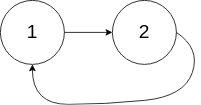1 Description #
source: https://leetcode.com/problems/linked-list-cycle/
Given a linked list, determine if it has a cycle in it.
To represent a cycle in the given linked list, we use an integer pos which represents the position (0-indexed) in the linked list where tail connects to. If pos is -1, then there is no cycle in the linked list.
Example 1:
Input: head = [3,2,0,-4], pos = 1
Output: true
Explanation: There is a cycle in the linked list, where tail connects to the second node.

Example 2:
Input: head = [1,2], pos = 0
Output: true
Explanation: There is a cycle in the linked list, where tail connects to the first node.

Example 3:
Input: head = [1], pos = -1
Output: false
Explanation: There is no cycle in the linked list.

Follow up:
Can you solve it using O(1) (i.e. constant) memory?
2 Solution #
# Definition for singly-linked list.
# class ListNode:
# def __init__(self, x):
# self.val = x
# self.next = None
# time complexity: O(n), n is the length of linkedList
# space complexity: O(n), n is the size of seen set.
class Solution:
def hasCycle(self, head: ListNode) -> bool:
seen = set()
while head:
if head in seen:
return True
seen.add(head)
head = head.next
return False
/**
* Definition for singly-linked list.
* struct ListNode {
* int val;
* ListNode *next;
* ListNode(int x) : val(x), next(NULL) {}
* };
*/
class Solution {
public:
bool hasCycle(ListNode *head) {
// Runtime complexity: O(n); n is the size of linked_list
// Space complexity: O(1)
if(!head){
return false;
}
ListNode* fast = head -> next;
while(head){
// if the fast pointer meets the slow pointer, there is a cycle
if (fast == head){
return true;
}
if(fast && fast ->next){
fast = fast->next->next;
} else{
// if there is a cycle, the fast-> next will never be null
return false;
}
head = head->next;
}
return false;
}
};